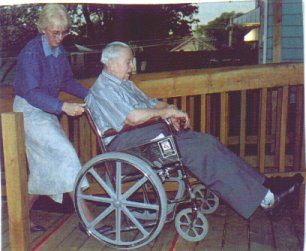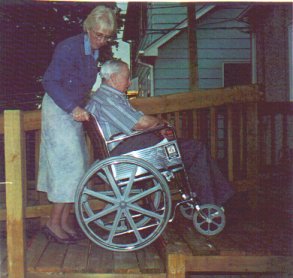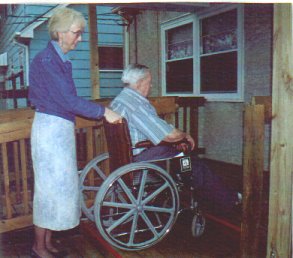Using a Wheelchair on Long-Tread Low-Riser Steps
 DVD Excerpt
DVD Excerpt:
The
Design Factors video
discusses designing for individual needs and includes video of the long-tread low-riser steps in use.
These videos are excerpted from the new Ramp Project DVD;
four excerpts are avalable online.
This DVD is
available for purchase from MCIL.
Long-tread low-riser steps can be used to assist a person who is using a
wheelchair in and out of their home. If the choice is made to use the
steps in this manner, please follow the advice given to reduce the chances
of injury to both the wheelchair user and the person assisting.
|
The same technique used to negotiate a curb can be used with the long-tread
low-riser steps.
|

|
1.
To assist someone up the steps, the wheelchair is tilted back, lifting the
front wheels high enough to clear the riser, and then rolled forward.
|

|
2.
When the back wheels contact the riser the helper can adjust their footing
and then use a rolling/lifting motion to move the chair fully onto the
next step. The helper should keep as much weight as possible on
the wheels and use just enough lift to move the chair up.
|

|
3.
The chair sits flat on each step, allowing the helper to stop and rest at
any time.
|
|
Assisting someone down the steps is accomplished by rolling them backwards
down the steps, one at a time, being careful to prevent the front wheels
of the chair from dropping too suddenly to the lower step.
Both the wheelchair user and the helper should be facing uphill when going
up and when going down the steps.
|
Properly designed ramps should be considered as the first choice for safe
wheelchair movement. When a ramp is impractical, the long-tread
low-riser steps provide a safer alternative than carrying an occupied wheelchair
on regular steps. The steps are not appropriate for independent
use by a person using a person using a wheelchair, and are not intended
to replace properly designed ramps. Electric wheelchairs and battery
powered carts should not be used with this type of step.
Before installing this type of step at a home, be sure the wheelchair user
and helper(s) have tried the technique described in the box above and are
comfortable with it.
Concerns for the safety of the wheelchair user or helper should be resolved
with therapy or medical personnel prior to using this technique.
The construction guide, "How to Build Ramps for Home
Accessibility," contains design advice and complete instructions
for installation of modular steps and modular wheelchair ramps. The
printed manual is available from:
Metropolitan Center
for Independent Living
1600 University Ave W, Suite 16
St. Paul, MN 55104-3825
Voice: 651-646-8342; TDD: 651-603-2001; Fax: 651-603-2006
The manual is also available on-line at
http://www.wheelchairramp.org.
 DVD Excerpt:
DVD Excerpt:


